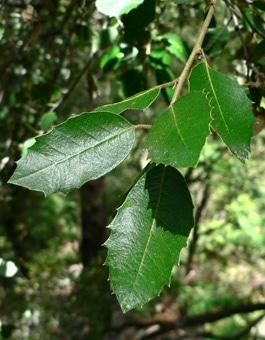

Tree or shrub, it's all about location
This oak grows best in sheltered canyons, and can reach heights of 80 feet or more. However, on exposed mountain slopes, it is often a small shrub forming dense thickets. Because it is an attractive tree that grows easily on steep, rocky slopes, it is desirable to urban planners as a slope stabilizer.
Range
In the northern part of its range, this oak often dominates steep, shallow, rocky ledges with little soil development. It can grow at elevations of 1,600 to 5,000 feet in southwestern Oregon and on the lower, interior slopes of Oregon’s Coast and Cascade ranges.
Character
An evergreen tree with a rounded, dense crown, it may also be a low shrub in dry, open habitats. The mature bark is gray and scaly. Leaves are oblong to elliptic, 1 to 1 ½ inches long, flat, firm and toothed at themargins. With older trees the leaves appear smoother.
Understory
Dense thickets and infertile soil keep its understory free of most other plants and shrubs. However, this species does provide shelter, and its acorns are an important source of food for jays, woodpeckers, mountain quail, ground squirrels and mule deer.
Climate
Canyon live oak occurs in climates characterized by mild, wet winters and hot, dry summers.
Management
Canyon live oak is considered a non-manageable hardwood; however, its rapid sprout growth make it an excellent source of fuel wood. Manufactured into paneling, the wood makes an attractive multicolored interior wall covering.